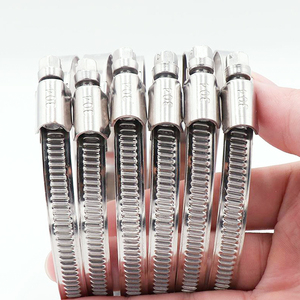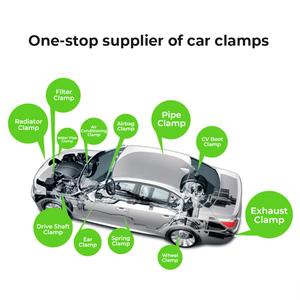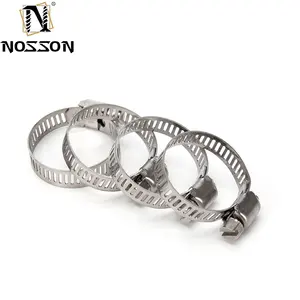
All categories
Featured selections
Trade Assurance
Buyer Central
Help Center
Get the app
Become a supplier

(1000 products available)


















































A water pump hose clamp is a device used to attach and seal a hose to a water pump or any fitting. There are different types of water pump hose clamps, including:
Stainless Steel Hose Clamp
This type of clamp is popular in the automotive and marine industries. It is also widely used in other applications. It offers a balance of durability and affordability. The clamp comes with a worm gear mechanism that enables precise adjustments. Its band and housing are made of stainless steel. It is resistant to corrosion and can withstand different environmental conditions.
Constant Tension Hose Clamp
This hose clamp is ideal for applications where temperature changes are experienced. It comes with a spring mechanism that provides constant pressure. This design ensures a leak-free connection. It is also referred to as a water pump hose clamp. It is suitable for use in automotive and industrial applications.
Plastic Hose Clamp
These hose clamps are lightweight and highly resistant to corrosion. They are made from durable nylon or other types of plastics. They are commonly used in small engines, automotive applications and where minimal weight is required. These water pump hose clamps are easy to install and come in various sizes. However, they offer minimal strength compared to metal hose clamps.
Spring Hose Clamp
This is a type of water pump hose clamp that uses a spring to hold the two ends together. It can be tightened or loosened based on the hose or tubing being used. These clamps provide a constant force to hold the hose tightly. They are commonly used in situations where hoses need to be changed quickly.
Gear Clamp
These are ideal for applications where a low cost and simple design are needed. It uses a metal strip as a band that encircles the hose. This type of clamp offers an excellent sealing force and is popular in many applications.
High-Pressure Hose Clamp
These clamps are designed specifically for high-pressure applications. They offer excellent resistance to blow-off and leakage. They are commonly used in hydraulic systems and applications where high-pressure water is experienced.
Water pump hose clamps have different features, including materials, sizes, designs, and operating functions. Here are some common features and functions of a water pump hose clamp.
Material
Water pump hose clamps are manufactured from different materials with unique characteristics and advantages. Stainless steel, mild steel, copper, and aluminum are some of the common materials used to make water pump hose clamps. Stainless steel is a popular option for the water pump hose clamp because it offers excellent corrosion resistance. It is often used in applications exposed to moisture, water, and other harsh elements. The stainless steel hose clamps provide aesthetic finishing, which is widely preferred in visible applications. Mild steel offers durability and strength. It is used where corrosion resistance is not a primary concern. The steel water pump hose clamps are often powder-coated or galvanized to enhance their corrosion resistance properties.
Construction
Water pump hose clamps are constructed in different styles to meet the requirements of different applications. The common construction styles of water pump hose clamps are:1/2 inch to 1 inch hose clamp, 2.5 inch to 3.25 inch hose clamp, 3.5 inch to 4.5 inch hose clamp, and 4.75 inch and larger hose clamp. The 1/2 inch to 1 inch hose clamps fit pipes or hoses with an outer diameter of 1 inch, and the common applications include PCV vent hoses, radiator hoses, and vacuum hoses. The 2.5 to 3.25 inch hose clamps fit pipes or hoses with an outer diameter of 2.5 to 3.25 inches, and the common applications include air intake ducts, larger radiator hoses, and drainage pipes.
Water pump hose clamps are used in a variety of industries and applications to secure hoses or pipes connected to pumps. Some common usage scenarios include:
Automotive Industry
These are used to secure radiator hoses, coolant hoses, fuel hoses, and air intake hoses in automotive engines. They ensure the proper flow of fluids or air in automotive systems.
Motorcycles
They are used to secure hoses in the cooling system, fuel delivery system, and intake system of motorcycles. A good example of these clamps is the motorcycle hose clamp.
Agriculture
These clamps are used in agriculture to secure hoses in irrigation systems, water pumps, and other fluid transfer systems on farms and agricultural machinery.
Industrial Equipment
Water pump hose clamps are commonly used in industrial settings to secure hoses connected to water pumps in various applications, including construction sites, manufacturing plants, and industrial machinery.
Marine Applications
These are used in boats and ships to secure hoses connected to water pumps, engines, bilge pumps, and cooling systems in marine environments.
Home Appliances
They can be found in appliances such as washing machines, dishwashers, and refrigerators to secure hoses connected to water pumps and ensure proper water flow.
Aquarium and Fish Tanks
In the context of aquariums and fish tanks, these clamps are used to secure hoses connected to water pumps, filters, and air pumps to ensure proper water circulation and oxygenation.
HVAC Systems
Water pump hose clamps are used in Heating, Ventilation, and Air Conditioning (HVAC) systems to secure hoses connected to pumps, refrigerants, and coolant systems in HVAC applications.
Construction Machinery
These clamps are used in construction machinery, such as excavators, bulldozers, and heavy equipment, to secure hoses connected to hydraulic pumps and other fluid transfer systems.
Clamp Size
The diameter of the hose should be measured to determine the proper size of the clamp. A size too big or too small will leak or not fit on the hose. Most clamps come in different sizes that will fit many different hoses. A clamp measuring the hose diameter should be purchased.
Material Selection
Water pump hose clamps are manufactured using different materials, each with advantages. Stainless steel is a great choice because it resists corrosion and is durable. If the application requires a hose that needs to handle a lot of pressure, a steel clamp is a good option. Steel is also more resistant to rust and works well in wet conditions. If price is more important than other factors, a zinc-plated clamp works at a lower cost.
Easy Installation
First, look for a hose clamp that is simple to install and adjust. Models that require no special tools to put on the hose should be considered. The type that can be installed and tightened just by turning a screw is a good choice. These types are easier than the ones that have to be tightened with a wrench.
Compatibility
Compatibility between the hose and the clamp must be ensured. The type of hose material must be considered. Some clamps work better with plastic, while others are good for metal or rubber hoses. The type of water pump used must be looked at. Different pumps may need different kinds of clamps for proper connection and to avoid leaks.
Brand and Reviews
The clamp's brand should be researched by reading reviews and ratings to find out how well it works. Consider products from well-known brands that many people have given positive feedback.
Q1. Are there any alternatives to a water pump hose clamp?
A1. There are no alternatives to a hose clamp for securing hoses on water pumps. The clamp comes in different types to suit various applications and requirements, and there are no suitable alternatives.
Q2. What's the typical material for these clamps?
A2. The most common material is stainless steel, which offers durability and resistance to rust and corrosion. Other materials include mild steel, plastic, and galvanized steel.
Q3. How is it installed?
Installation involves placing the clamp around the hose and water pump connection. The screw or bolt is then tightened to secure the hose and water pump. Proper positioning and tightness are important for avoiding leaks and damage.